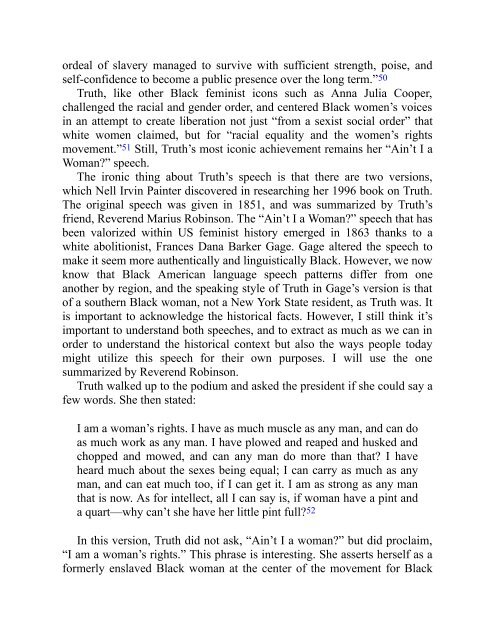You also want an ePaper? Increase the reach of your titles
YUMPU automatically turns print PDFs into web optimized ePapers that Google loves.
ordeal <strong>of</strong> slavery managed to survive with sufficient strength, poise, and<br />
self-confidence to become a public presence over <strong>the</strong> long term.” 50<br />
Truth, like o<strong>the</strong>r Black feminist icons such as <strong>An</strong>na Julia Cooper,<br />
challenged <strong>the</strong> racial and gender order, and centered Black women’s voices<br />
in an attempt to create liberation not just “from a sexist social order” that<br />
white women claimed, but for “racial equality and <strong>the</strong> women’s rights<br />
movement.” 51 Still, Truth’s most iconic achievement remains her “Ain’t I a<br />
Woman?” speech.<br />
The ironic thing about Truth’s speech is that <strong>the</strong>re are two versions,<br />
which Nell Irvin Painter discovered in researching her 1996 book on Truth.<br />
The original speech was given in 1851, and was summarized by Truth’s<br />
friend, Reverend Marius Robinson. The “Ain’t I a Woman?” speech that has<br />
been valorized within US feminist history emerged in 1863 thanks to a<br />
white abolitionist, Frances Dana Barker Gage. Gage altered <strong>the</strong> speech to<br />
make it seem more au<strong>the</strong>ntically and linguistically Black. However, we now<br />
know that Black American language speech patterns differ from one<br />
ano<strong>the</strong>r by region, and <strong>the</strong> speaking style <strong>of</strong> Truth in Gage’s version is that<br />
<strong>of</strong> a sou<strong>the</strong>rn Black woman, not a New York State resident, as Truth was. It<br />
is important to acknowledge <strong>the</strong> historical facts. However, I still think it’s<br />
important to understand both speeches, and to extract as much as we can in<br />
order to understand <strong>the</strong> historical context but also <strong>the</strong> ways people today<br />
might utilize this speech for <strong>the</strong>ir own purposes. I will use <strong>the</strong> one<br />
summarized by Reverend Robinson.<br />
Truth walked up to <strong>the</strong> podium and asked <strong>the</strong> president if she could say a<br />
few words. She <strong>the</strong>n stated:<br />
I am a woman’s rights. I have as much muscle as any man, and can do<br />
as much work as any man. I have plowed and reaped and husked and<br />
chopped and mowed, and can any man do more than that? I have<br />
heard much about <strong>the</strong> sexes being equal; I can carry as much as any<br />
man, and can eat much too, if I can get it. I am as strong as any man<br />
that is now. As for intellect, all I can say is, if woman have a pint and<br />
a quart—why can’t she have her little pint full? 52<br />
In this version, Truth did not ask, “Ain’t I a woman?” but did proclaim,<br />
“I am a woman’s rights.” This phrase is interesting. She asserts herself as a<br />
formerly enslaved Black woman at <strong>the</strong> center <strong>of</strong> <strong>the</strong> movement for Black


















